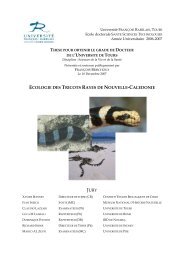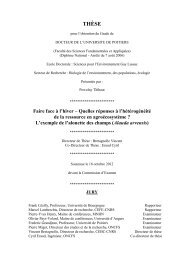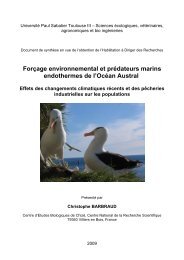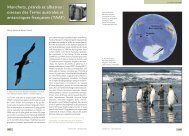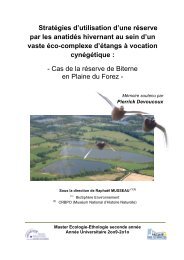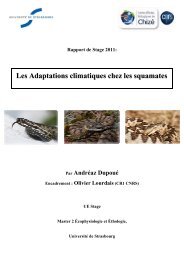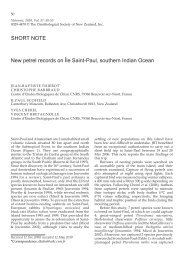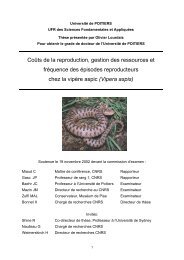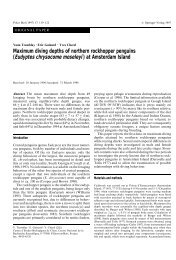Fourth International Orca Symposium and Workshop - CEBC - CNRS
Fourth International Orca Symposium and Workshop - CEBC - CNRS
Fourth International Orca Symposium and Workshop - CEBC - CNRS
You also want an ePaper? Increase the reach of your titles
YUMPU automatically turns print PDFs into web optimized ePapers that Google loves.
(i.e. three to five months later than their peak in abundance around the sub-Antarctic isl<strong>and</strong>s).<br />
The observed difference in the timing of peak abundance in killer whales might be related to<br />
dispersing killer whales passing through different latitudes at different times (Mikhalev et al.<br />
1981).<br />
Group size - The overall mean group size for the whole study period was approximately<br />
four individuals (Keith et al. 2001; Condy et al. 1978). Elsewhere group sizes varied between<br />
1-15 individuals, with an average of three animals (Baird & Dill 1995), while Mikhalev et al.<br />
(1981) found the most frequent group size to be six to eight animals, although the numbers<br />
varied between one to several hundred animals.<br />
Sex <strong>and</strong> age composition - Adult females predominated (Keith et al. 2001) whereas<br />
Condy et al. (1978) calculated that killer whales had a sex/age composition of 28.7% adult<br />
males, 21.4% adult females, 24.7% subadults, 7.8% calves <strong>and</strong> an unidentified class of 17.4%<br />
at Marion Isl<strong>and</strong>. However, comparison between studies is complicated due to the difficulty in<br />
distinguishing between a subadult male <strong>and</strong> an adult female.<br />
Diurnal sighting frequencies - Killer whales were only observable from dawn to dusk<br />
with a peak of opportunistic observations during late afternoon (Condy et al. 1978; Keith et<br />
al. 2001), a probable result of increased human activity around the base station at that<br />
particular time of the day. The dawn-to-dusk surveys (DDUs), on the other h<strong>and</strong>, produced a<br />
relatively constant distribution of sightings throughout the day (Keith et al. 2001; Pistorius et<br />
al. 2002).<br />
Photogrammetry - The Defran et al. (1990) method for photogrammetry could only be<br />
used on a few individuals that did possess unique, useable markings. The Heimlich-Boran<br />
(1986) method suffered from the varied placing of a base line (BL), but the methods devised<br />
(Keith et al. 2001) provide a quantitative way to position the BL. It may only become evident<br />
after obtaining improved photographs, whether the proposed new adapted methods (Keith et<br />
al. 2001) will improve the photogrammetric analysis method of Heimlich-Boran (1986).<br />
Photo-identification - Many of the photographs of the killer whales were of poor quality<br />
<strong>and</strong> taken from a great distance which made reliable identification difficult (Keith et al.<br />
2001). The opportunistic <strong>and</strong> sporadic nature of photographing the killer whales at Marion<br />
Isl<strong>and</strong> precluded all of the killer whales being photographed. Due to the nature of the<br />
photographs, which concentrated on individuals, groups could not be distinguished from the<br />
photographs. One female with distinct markings on the dorsal fin, first identified in 1973, was<br />
still present around the isl<strong>and</strong> in 1993, at an age in excess of 20 years.<br />
Population size - We identified 26 whales in seven pods during the early morning to late<br />
afternoon sightings on the isl<strong>and</strong>-wide vigil (13 December 2000). A second method indicated<br />
that 29 individuals moved north past the base station between 15h28 <strong>and</strong> 17h55, while a third<br />
estimate of abundance suggested that 20 killer whales were seen in front of the base station,<br />
three at Archway, <strong>and</strong> three were seen at 16h02 approaching from the west at Pinnacles<br />
(Pistorius et al. 2002). Therefore, we think that there were between 25 <strong>and</strong> 30 killer whales<br />
hunting around Marion Isl<strong>and</strong> during their peak presence in early December 2000.<br />
Human impact - Marion Isl<strong>and</strong> has recently been proposed as an eco-tourism destination<br />
(Heydenrych & Jackson 2000) <strong>and</strong> killer whale ‘watching’ could become a realistic tourist<br />
attraction. Looking solely at the seasonal <strong>and</strong> diurnal pattern of the occurrences, “orca”<br />
FOURTH INTERNATIONAL ORCA SYMPOSIUM AND WORKSHOPS<br />
SEPTEMBER 23-28 2002, <strong>CEBC</strong>-<strong>CNRS</strong>, France<br />
36



